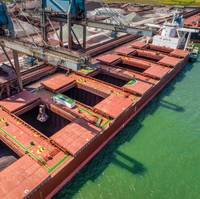Baltic Index Falls on Weakness in Capesize Rates

The Baltic Exchange's main sea freight index edged lower on Thursday as a decline in capesize rates overshadowed advances in the panamax segment.The overall index, which factors in rates for capesize, panamax, and supramax shipping vessels carrying dry bulk commodities, ticked down by 7 points, or 0.6%, to 1,137.The capesize index fell 78 points, or 4.5%, to 1,674, declining for the third straight session.Average daily earnings for capesizes .BATCA, which typically transport 150,000-ton cargoes carrying commodities such as iron ore and coal, decreased by $643 to $13,883.Dalian iron ore futures
Bangladesh at Front of Shipbreaking Activity
There has been a firm level of ship demolition activity in the first four months of 2015 and the two largest owner regions, Asia/Pacific and Europe account for 88% of the tonnage sold for recycling, according to the latest review of shipbreaking trend by Clarkson Research. Whilst the Indian Sub-Continent remains the main demolition destination, recent activity has seen Bangladeshi breakers take the lead. This month, by Clarkson Research take a closer look at the country trends behind global demolition. The majority of tonnage is demolished in the Indian Sub-Continent and in the ytd Bangladeshi breakers have scrapped a reported 3.2m GT, 30% of the global total.
Antwerp Port off to good start after record year
The port of Antwerp handled 48,166,806 tonnes of freight in the first three months of this year, 2.5% more than in the same period last year. Container freight did well, while ro/ro and liquid bulk also produced good growth figures. The container volume rose once more during the first quarter by 2.1%, to 26,004,571 tonnes. This corresponds to 2,146,392 TEU (up 0.9%). Ro/ro also did well during the past three months, with 1,184,608 tonnes or an increase of 5.8% compared with the first quarter of last year. The number of cars handled for its part rose by 2.5% to 313,436. Conventional breakbulk however was down by 9.1% during the first quarter, to 2,407,726 tonnes.







